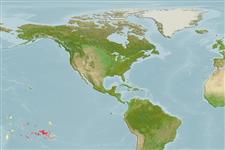Environment: milieu / climate zone / depth range / distribution range
Ecologia
marino associati a barriera corallina; non migratori. Tropical
Eastern Central Pacific: Cook (Ref. 34027) and Society islands. Needs better reference.
Size / Peso / Age
Maturity: Lm ? range ? - ? cm
Max length : 14.5 cm SL maschio/sesso non determinato; (Ref. 28618)
Life cycle and mating behavior
Maturities | Riproduzione | Spawnings | Egg(s) | Fecundities | Larve
Randall, J.E. and P.C. Heemstra, 2006. Review of the Indo-Pacific fishes of the genus Odontanthias (Serranidae: Anthiinae), with descriptions of two new species and a related genus. Indo-Pac. Fish. (38):32 p. (Ref. 57080)
IUCN Red List Status (Ref. 130435)
Threat to humans
Harmless
Human uses
Strumenti
Special reports
Download XML
Fonti Internet
Estimates based on models
Preferred temperature (Ref.
123201): 4.8 - 6.9, mean 5.7 °C (based on 11 cells).
Phylogenetic diversity index (Ref.
82804): PD
50 = 0.5000 [Uniqueness, from 0.5 = low to 2.0 = high].
Trophic level (Ref.
69278): 3.4 ±0.4 se; based on size and trophs of closest relatives
Resilienza (Ref.
120179): Alto, tempo minimo di raddoppiamento della popolazione meno di 15 mesi (Preliminary K or Fecundity.).
Fishing Vulnerability (Ref.
59153): Low vulnerability (10 of 100).
